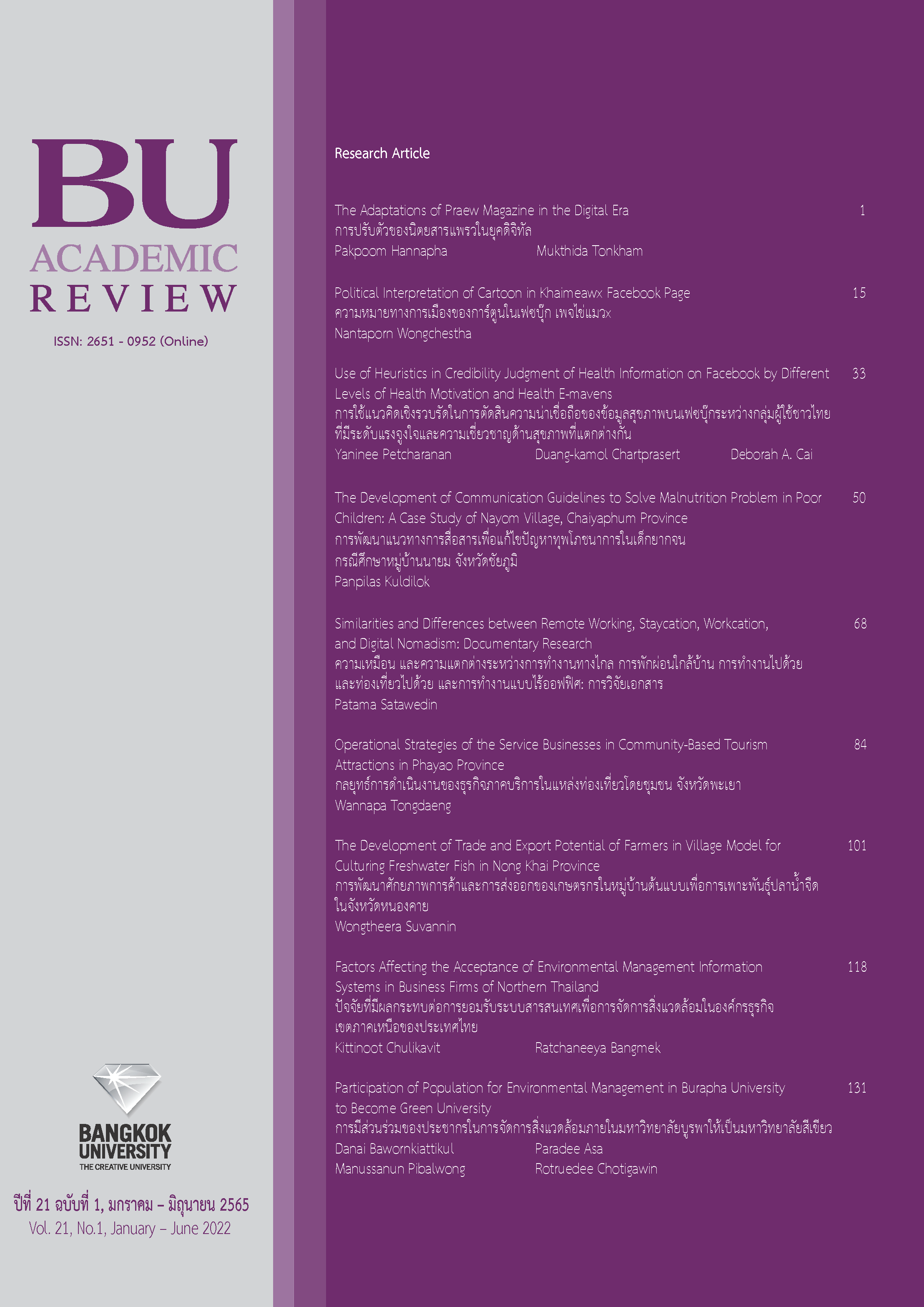The Adaptations of Praew Magazine in the Digital Era
Main Article Content
Abstract
The aim of this study is two-fold. Firstly, it attempts to investigate the adaptations of Praew magazine in the digital era. Secondly, it purports to examine the factors contributing to its survival in the digital era. Using the theory of mass communication organization administration, corporate communication concept, strategic management theory and digital marketing theory as theoretical frameworks, this study employed qualitative research methods which included an in-depth interview with Siripen Palanchai, the executive manager of Praew magazine, and document analysis.
The findings indicate that the adaptations of Praew magazine for survival include (1) the management of media organization, (2) corporate communication, (3) strategic management, and (4) the adaptation of marketing patterns which requires simultaneous adaptation of these four aspects. To do this, it is necessary that the executive cope with the changes caused by the joint venture with new business alliances by communicating down to personnel in order to encourage them to develop their potential along with the organization. With regards to production, it was found that there is a decrease in the number of production to reduce the budget. Moreover, pre-orders of magazine are used to avoid risk. In terms of marketing, online websites and social media platforms are also used to reach customers.
In addition, the findings suggest two factors affecting the survival of Praew magazine –the internal factors and the external factors. The internal factors involve factors pertaining to organization administration, cooperate values, cooperate culture, leadership, ownership of magazine, and corporate communication. The external factors include finding business partners with funding readiness, business expertise, and financial status. Establishing a healthy relationship with various business groups helps increase confidence in business operation. Another important external factor concerns continuous improvement of technology, the creation of comprehensive quality printing and the integration of printing with new media in the digital era.
Article Details

This work is licensed under a Creative Commons Attribution-NonCommercial-NoDerivatives 4.0 International License.
The manuscript submitted for publication must be the original version, submitted only to this particular journal with no prior acceptance for publication elsewhere in other academic journals. The manuscript must also not violate the copyright issue by means of plagiarism.
References
Attanon, N., Phadermkuekulpong, K., Sajja, M., Suphayasarn, T., Tantemsub, N., & Sukko, S. (2017).
Thailai nittayasān Thai [Thai magazine timeline]. Retrieved March 3, 2020, from
https://workpointtoday.com/thai-magazine-timeline/
Bangkok Biz News. (2019, December 18). Khōtsanā pī hoksipsām ding ' thī wī ' sō̜ satsūan tam hāsip
kō̜ kā khrang rǣk [Advertising industry in the year 2020: Collapse of TV advertising industry
with a low proportion of 50% for the first time]. Retrieved February 25, 2020, from
https://www.bangkokbiznews.com/news/detail/858728
Brand Buffet. (2019). Yō̜n dū sip rư̄ang dēn kap kān plīanplǣng ʻutsāhakam sư̄ pī sō̜ngphansipkāo
[A look back at the top 10 news stories on changes of media industry 2019].
Retrieved January 18, 2020, from https://www.brandbuffet.in.th/2019/12/
thailand-media-industry-report-2019/
Buranadechachai, S. (2018). Wārasānsāt lō̜m rūam: nǣokhit lakkān læ kō̜ranī sưksā nai prathēt
Thai [Convergence journalism: Concept principle and case studies in Thailand]. Bangkok:
Danex Intercorporation Company Limited.
Ryan, D., & Jones, C. (2009). Understanding digital marketing, marketing strategies for engaging
the digital generation. London: Kogan Page Limited.
Isranews. (2019, December 30). Sathānakān sư̄ Thai rō̜p pī sō̜ngphanharoyhoksipsō̜ng suit nak fā
mō̜rasum sū ʻōkāt mai] Thailand’s social media trends 2019. Retrieved January 18, 2020,
from https://www.isranews.org/thaireform/thaireform-news/83992-media-83992.html
Jantrawattanakul, D. S., & Permpoon, J. (2014). Lak læ nǣokhit wārasānsāt convergence
[Principles of convergence journalism]. Bangkok: Thai Journalists Association.
Kanlayanee. (2020). Nittayasān khāo [New magazine]. Retrieved January 18, 2020, from
http://kanlayanee.ac.th/wbiprinting/WBI/wbi_7/Lesson/compos_4.htm
Lertdecha, R. (2015). Kān prap tūa khō̜ng nittayasān nai thotsawat thī sō̜ngphansip -
sō̜ngphanyīsip [The adaptation of magazine in 2010 – 2020] (Master’s thesis, Thammasat
University).
McQuail, D. (2005). McQuail’s mass communication theory: An introduction (5th ed.). London:
Sage.
National Statistical Office. (2018). Samrūat kānmī kānchai theknōlōyī sārasonthēt læ kānsư̄sān nai
khrūarư̄an [ICT usage survey Thailand]. Retrieved January 18, 2020, from
http://www.nso.go.th/sites/2014/
Surasonthi, K. (2005). Khwāmrū thāngkān sư̄sān (Phim khrang thī sī) [Introduction to
communication (4th ed.)]. Bangkok: Faculty of Journalism and Mass Communication,
Thammasat University.
Tcijthai. (2019, November 3 ). Sư̄ singphim Thai nai yuk Disrupt [Thailand’s print media in the
disruption era]. Retrieved January 18, 2020, from https://www.tcijthai.com/
news/2019/11/scoop/9541
Thai Post. (2019, December 14). Mai hen patčhai būak ʻemʻai pramœ̄n metngœ̄n khōtsanā pī
hoksipsām titlop nǣ [Not seeing positive factors: “MI” estimates negative advertising
budget in the year 2020]. Retrieved February 25, 2020, from
https://www.thaipost.net/main/detail/52677
Thansettakij. (2019, December 30 ). Sathānakān sư̄ pī hoksipsō̜ng " sut nak fā mō̜rasum sū ʻōkāt
mai " [Thailand’s social media trends 2019: Collapsed, struggled, and new opportunity].
Retrieved March 3, 2020, from https://www.thansettakij.com/politics/417807
Think About Wealth. (2019, May 31). Sathiti phūchai dičhithan thūa lōk sō̜ngphansipkāo Khon Thai
chai tit net māk sut nai lōk [Global digital users statistics 2019: Thailand ranks first].
Retrieved January 18, 2020, from https://www.thinkaboutwealth.com/
digitalstatworld-thailand2019/
Yawiraj, N. (2010). Kānčhatkān samai mai (Phim khrang thī sip) [Modern management (10th ed.).
Bangkok: Triple Group Company Limited.


